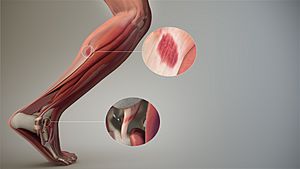Sprain facts for kids
A sprain happens when you stretch or tear a ligament. Ligaments are strong bands of tissue that connect your bones. Sprains are common injuries, often happening during sports or falls. They can cause pain and swelling, much like a broken bone, but they are usually less serious.
Contents
Types of Sprains
Sprains are put into three groups, depending on how bad the injury is:
Mild Sprain (First Degree)
- This is a slight stretch or a very small tear in a ligament. It might feel a little sore.
Moderate Sprain (Second Degree)
- This means a bigger tear in the ligament. You will likely feel more pain and see swelling. It can be hard to use the injured part.
Severe Sprain (Third Degree)
- This is the most serious type. The ligament is completely torn apart. This causes a lot of pain and swelling. You might not be able to move the injured joint at all.
What a Sprain Feels Like
When you sprain something, you will usually notice these signs:
- Pain: The injured area will hurt, especially when you try to move it.
- Swelling: The area around the injury will get puffy.
- Trouble Moving: It might be hard to use the injured body part. You might not be able to put weight on it or move it normally.
Common Sprain Locations
While any joint can get sprained, some places are more common:
- The ankle: This is the most common place to get a sprain. It often happens when you twist your ankle while running or jumping.
- The knee: A common knee sprain is to the anterior cruciate ligament (ACL). This is a serious injury, often seen in athletes who play sports like basketball, soccer, or judo.
- The fingers: Sprains can happen in your fingers, especially if they get bent backward or hit hard.
- The wrist: Your wrist can get sprained if you fall and land on your hand.
How to Prevent Sprains
You can help prevent sprains by:
- Using safety gear: Wear wrist or ankle guards if you play sports that put these joints at risk.
- Warming up and cooling down: Always do some light exercise and stretching before and after physical activity.
- Being aware: Pay attention to where you are walking or playing to avoid falls.
- Staying strong and flexible: Regular exercise helps keep your muscles and joints strong. This makes them less likely to get injured.
See also
 In Spanish: Esguince para niños
In Spanish: Esguince para niños

All content from Kiddle encyclopedia articles (including the article images and facts) can be freely used under Attribution-ShareAlike license, unless stated otherwise. Cite this article:
Sprain Facts for Kids. Kiddle Encyclopedia.

